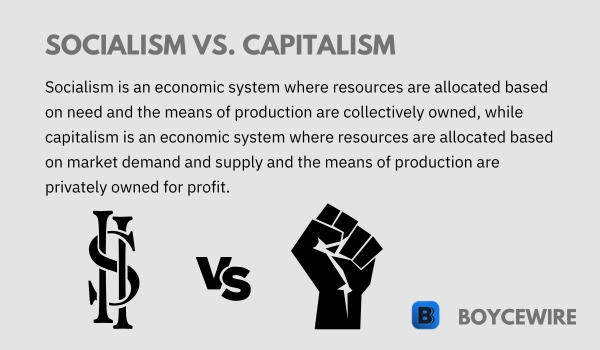Socialism vs Capitalism

Introduction
Socialism and capitalism represent two distinct economic and political ideologies that have shaped the modern world in various ways. As the global economy and political landscape continue to evolve, understanding the key differences between these systems becomes increasingly important.
This article aims to provide a comprehensive overview of the fundamental principles, economic structures, and real-world implications of socialism and capitalism. By comparing and contrasting these ideologies, we can better appreciate their respective strengths, weaknesses, and the diverse ways they have been implemented throughout history. In doing so, we can foster a more informed and nuanced understanding of the ongoing debates surrounding the merits of socialism and capitalism in shaping economic and social outcomes.
Key Points
- Capitalism is an economic system where private individuals and businesses own and operate the means of production for profit.
- Socialism is an economic system where the means of production, such as factories and farms, are owned and controlled by the state or by the workers themselves.
- In capitalism, resources are allocated based on market demand and supply, while in socialism, resources are allocated based on need.
- Most countries have mixed economies that combine elements of both capitalism and socialism.
Comparison Overview
| Aspect | Socialism | Capitalism |
|---|---|---|
| Ownership of means of production | Collective ownership by the state or workers | Private ownership by individuals or corporations |
| Distribution of wealth | Equal distribution among all members of society | Unequal distribution based on market forces and individual effort |
| Role of government | Centralized control over the economy and society | Minimal government intervention in the economy and society |
| Individual rights | Subordinated to the collective welfare | Emphasized as paramount |
| Innovation | Encouraged by state investment and planning | Encouraged by competition and profit motive |
| Efficiency | May be lower due to centralized decision-making and lack of market signals | May be higher due to competition and market signals |
| Income inequality | Lower overall, but less opportunity for individual wealth accumulation | Higher overall, but greater opportunity for individual wealth accumulation |
| Environmental impact | Generally prioritizes conservation and sustainability over economic growth | May prioritize economic growth over conservation and sustainability |
| Access to basic needs | May provide universal access to healthcare, education, and housing | May provide access based on ability to pay or market demand |
| Job security | May provide more job security through state ownership or regulation | May provide less job security due to market fluctuations and competition |
Historical Background
Origins and Development of Capitalism
Capitalism has its roots in the late Middle Ages and early Renaissance in Europe. As trade and commerce expanded, new forms of economic organization emerged, replacing the feudal system that had dominated the medieval period. The rise of mercantilism in the 16th and 17th centuries laid the foundation for capitalism, with its focus on accumulating wealth through trade and maximizing exports.
The Industrial Revolution, which began in the late 18th century, marked a significant turning point in the development of capitalism. Rapid advancements in technology, transportation, and manufacturing led to the growth of factories and urban centers, transforming the economic landscape. During this period, classical economic thinkers like Adam Smith, David Ricardo, and Thomas Malthus contributed to the development of capitalist theory, emphasizing the importance of free markets, private property, and the division of labor.
Over time, capitalism has evolved and adapted to various economic and social changes, with the rise of corporate capitalism in the late 19th and early 20th centuries and the emergence of neoliberalism in the late 20th century being notable examples.
Origins and Development of Socialism
Socialism, as an economic and political ideology, emerged in the early 19th century as a response to the social and economic inequalities and injustices produced by the rapid industrialization and expansion of capitalism. Early socialist thinkers like Charles Fourier, Robert Owen, and Henri de Saint-Simon criticized the exploitation of workers, poverty, and environmental degradation associated with capitalism, proposing alternative economic systems based on cooperation and collective ownership.
The publication of “The Communist Manifesto” by Karl Marx and Friedrich Engels in 1848 and the works of Marx, including “Das Kapital,” significantly influenced the development of socialist thought. Marxism provided a comprehensive critique of capitalism, arguing that it was inherently exploitative and would eventually be replaced by socialism and ultimately communism.
Throughout the 19th and 20th centuries, socialism evolved into various forms and branches, including democratic socialism, social democracy, and revolutionary socialism. The Russian Revolution of 1917, led by Vladimir Lenin and the Bolshevik Party, marked the establishment of the world’s first socialist state, the Soviet Union, and significantly impacted the trajectory of socialism in the 20th century.
In conclusion, the historical development of socialism and capitalism has been shaped by economic, social, and political forces over time, with each ideology evolving and adapting in response to changing circumstances. Understanding this historical context is crucial for appreciating the differences between socialism and capitalism, as well as their respective strengths and weaknesses.
Fundamental Principles
Capitalism
Capitalism is based on several key principles that define its economic and political framework. The first principle is the free market, which allows for voluntary exchange between buyers and sellers, driven by supply and demand. The market determines prices, production, and distribution of goods and services, with minimal government intervention.
The second principle of capitalism is private property, which grants individuals and businesses the right to own, manage, and dispose of assets, such as land, buildings, and intellectual property. This principle allows for individuals to accumulate wealth and invest in new ventures, fostering economic growth and innovation.
The third principle is the profit motive, which encourages individuals and businesses to maximize their earnings by efficiently allocating resources and responding to market demand. The pursuit of profit incentivizes competition, innovation, and productivity, driving economic growth and prosperity.
Socialism
Socialism, in contrast, is founded on a different set of principles that emphasize collective ownership, wealth redistribution, and government involvement in the economy. The first principle is collective ownership, which posits that the means of production, such as factories, land, and natural resources, should be owned and managed collectively, either through the state or cooperatives. This principle aims to prevent exploitation and ensure that the benefits of production are shared more equitably among society.
The second principle of socialism is the reduction of income inequality. Socialism seeks to create a more just and equitable society by redistributing wealth and resources, either through progressive taxation, social welfare programs, or direct government intervention. This principle is grounded in the belief that everyone should have access to basic goods and services, such as healthcare, education, and housing, regardless of their ability to pay.
The third principle is the significant government involvement in the economy. In a socialist system, the government plays a central role in planning and directing economic activity, regulating industries, and providing public goods and services. This principle seeks to address market failures, promote social welfare, and protect the environment, among other objectives.
Economic Structures
Capitalism: Market-Driven Economy
In a capitalist economic structure, the market plays a crucial role in determining the allocation of resources, production, and distribution of goods and services. Capitalism relies on the forces of supply and demand to set prices and wages, with businesses competing to attract customers and maximize profits. Private ownership of businesses and industries allows for the accumulation of wealth and investment in new ventures, fostering innovation and economic growth.
Capitalist economies typically feature a minimal level of government intervention in the market. The government’s primary role is to enforce property rights, maintain a legal framework for contracts, and ensure a level playing field for competition. In some cases, governments may intervene to address market failures, provide public goods and services, or protect consumers and the environment, but the overall emphasis is on market-driven outcomes.
Socialism: Mixed Economy
Socialist economic structures differ significantly from capitalism in terms of the balance between market mechanisms and government intervention. In a socialist economy, the means of production are either owned by the state or managed collectively through cooperatives. While market mechanisms may still operate to some extent, the government plays a more active role in managing the economy and redistributing wealth.
Socialist economies often feature a mix of private and public ownership, with key industries and resources being nationalized or placed under government control. Governments in socialist systems are responsible for planning and directing economic activity, setting production goals, and regulating industries to ensure social and environmental objectives are met.
Socialist economies also place a strong emphasis on reducing income inequality and providing public goods and services, such as healthcare, education, and housing. This often involves significant government intervention in the form of progressive taxation, social welfare programs, and direct investment in public infrastructure and services.
In summary, the primary difference between the economic structures of socialism and capitalism lies in the balance between market forces and government intervention. Capitalism emphasizes market-driven outcomes, private ownership, and the profit motive, while socialism emphasizes collective ownership, wealth redistribution, and significant government involvement in the economy.
Role of the Government
Capitalism: Limited Government Intervention
In a capitalist system, the role of the government is generally limited to ensuring a stable and fair economic environment in which businesses can operate and compete. The government’s primary functions include enforcing property rights, maintaining a legal framework for contracts, and providing basic public goods and services, such as infrastructure, national defense, and law enforcement.
Capitalist governments typically allow market forces to determine the allocation of resources, production, and distribution of goods and services. While some level of government intervention may be necessary to address market failures, protect consumers, or preserve the environment, the overall emphasis is on minimizing government involvement in economic affairs and allowing the market to operate as freely and efficiently as possible.
Socialism: Significant Government Involvement
In a socialist system, the role of the government is much more expansive, with the state playing a central role in managing the economy and redistributing wealth. In addition to providing public goods and services, socialist governments are responsible for planning and directing economic activity, setting production goals, and regulating industries to achieve social and environmental objectives.
Under socialism, the government may own or control key industries and resources, either through direct ownership or regulation. This enables the state to influence the allocation of resources and ensure that the benefits of production are shared more equitably among the population.
Socialist governments also prioritize reducing income inequality and providing essential services, such as healthcare, education, and housing. This often involves significant government intervention in the form of progressive taxation, social welfare programs, and direct investment in public infrastructure and services.
In conclusion, the role of the government in socialism and capitalism differs significantly, with capitalist governments focusing on limited intervention and maintaining a stable economic environment, while socialist governments emphasize wealth redistribution and actively manage the economy to promote social welfare and achieve policy objectives.
Income Distribution and Social Welfare
Capitalism: Income and Wealth Distribution Determined by Market Forces
In a capitalist system, income and wealth distribution are largely determined by market forces, such as supply and demand, individual skills, and education. The market rewards individuals and businesses based on their productivity, innovation, and ability to satisfy consumer demand. As a result, income inequality can be significant, with wealth concentrated among those who own capital and possess unique skills or resources.
Although some capitalist countries implement social welfare programs and progressive taxation to address income inequality, the primary focus is on creating opportunities for economic growth and allowing individuals to succeed based on their abilities and efforts. Critics argue that income inequality in capitalist systems can lead to social unrest, reduced social mobility, and a lack of access to essential goods and services for those in lower income brackets.
Socialism: Reducing Income Inequality and Welfare Programs
In contrast, socialism places a strong emphasis on reducing income inequality and ensuring that all members of society have access to essential goods and services. Under a socialist system, the government plays a significant role in redistributing wealth through progressive taxation, social welfare programs, and direct provision of public services, such as healthcare, education, and housing.
Socialist governments aim to create a more equitable society by narrowing the gap between the rich and the poor and ensuring that everyone has access to a basic standard of living. This often involves policies that promote worker rights, job security, and a living wage, as well as investments in public infrastructure and services that benefit the entire population.
While socialism’s focus on income redistribution and social welfare can lead to a more equitable society, critics argue that it can also create inefficiencies in resource allocation, disincentives for innovation, and a potential for bureaucratic mismanagement.
In summary, the primary difference between socialism and capitalism in terms of income distribution and social welfare lies in the emphasis placed on reducing income inequality and providing essential goods and services. Capitalism relies on market forces to determine income and wealth distribution, while socialism actively intervenes to promote a more equitable society through government policies and programs.
Real-World Examples
Capitalism
Capitalism can be observed in various forms around the world, with some countries implementing more laissez-faire policies and others adopting more mixed-market approaches. Here are a few examples:
United States
The U.S. is often seen as a prime example of a capitalist country, with its market-driven economy, private ownership of businesses, and focus on individual freedom and entrepreneurship. However, it should be noted that the U.S. also has various government regulations and social safety net programs in place, making it a mixed economy.
United Kingdom The UK’s economy is also predominantly capitalist, with a strong emphasis on free markets, private ownership, and competition. However, it also has a comprehensive social welfare system, including public healthcare through the National Health Service (NHS), demonstrating a mix of capitalist and socialist elements.
Hong Kong
Known for its low levels of government intervention, Hong Kong has long been considered one of the world’s most laissez-faire capitalist economies. With minimal taxation and regulation, it has become a hub for international trade and finance.
Socialism
Socialism takes different forms around the world, often blending with elements of capitalism to create mixed economies. Here are a few examples:
Nordic countries (Sweden, Norway, Denmark, Finland)
These countries are often cited as examples of democratic socialism or social democracy. They have mixed economies that combine free market capitalism with strong social welfare programs, progressive taxation, and government involvement in key industries. While private ownership of businesses is prevalent, the government plays a significant role in providing healthcare, education, and other public services, resulting in low levels of income inequality and high standards of living.
United Kingdom (post-WWII)
After World War II, the UK saw a period of increased government involvement in the economy, with the nationalization of key industries such as coal, steel, and railroads, and the establishment of the NHS. Although these policies were later rolled back in the late 20th century, this period serves as an example of socialism in practice within a mixed economy.
It is essential to recognize that the real-world examples of socialism and capitalism often involve a blend of both ideologies, with countries adopting various policies and practices to suit their unique historical, cultural, and economic contexts. This demonstrates the complex and evolving nature of economic systems and the ways in which they can incorporate elements of both socialism and capitalism to address their specific needs and challenges.
Criticisms and Challenges
Criticisms of Capitalism
- Income inequality: Critics argue that capitalism can lead to significant income inequality, with wealth being concentrated among a small percentage of the population. This can result in social unrest, reduced social mobility, and limited access to essential goods and services for those in lower income brackets.
- Exploitation of workers: Capitalism’s emphasis on profit maximization can lead to the exploitation of workers through low wages, poor working conditions, and job insecurity. Critics argue that this can result in a race to the bottom as companies compete to cut costs and maximize profits at the expense of worker welfare.
- Environmental degradation: The pursuit of profit and economic growth in capitalist systems can often result in negative externalities, such as pollution, deforestation, and overconsumption of resources. Critics argue that capitalism lacks the necessary incentives to prioritize environmental protection and sustainable development.
Criticisms of Socialism
- Inefficiency: Critics argue that socialist systems can be less efficient in allocating resources than capitalist systems, as government planning and intervention can result in bureaucratic mismanagement, corruption, and a lack of responsiveness to consumer demand.
- Disincentives for innovation and hard work: Socialism’s focus on income redistribution and collective ownership can create disincentives for innovation and hard work, as individuals may not receive the full benefits of their efforts. Critics argue that this can result in lower productivity, reduced economic growth, and a lack of technological progress.
- Loss of individual freedom: Critics of socialism argue that the increased government involvement in the economy and the emphasis on collective ownership can result in a loss of individual freedom and autonomy, as individuals have less control over their economic choices and opportunities.
Challenges for Both Systems
- Globalization and technological advancements: Both socialist and capitalist systems face challenges in adapting to the rapidly changing global economy, which has been marked by increased globalization, technological advancements, and the rise of multinational corporations. These developments have raised questions about the ability of national governments to manage their economies effectively and ensure the well-being of their citizens.
- Balancing growth and sustainability: As concerns about environmental degradation and resource depletion become more pressing, both socialism and capitalism face the challenge of balancing economic growth with sustainable development. This requires finding ways to incentivize businesses and individuals to prioritize environmental protection, reduce waste, and adopt sustainable practices.
In conclusion, both socialism and capitalism have their own unique criticisms and challenges. While capitalism is often criticized for income inequality, worker exploitation, and environmental degradation, socialism faces concerns related to inefficiency, disincentives for innovation, and a potential loss of individual freedom. Both systems need to adapt and evolve to address the changing economic landscape and the pressing global challenges of the 21st century.
Conclusion
In conclusion, socialism and capitalism represent two distinct economic and political ideologies, each with its own set of principles, objectives, and approaches to managing the economy. Capitalism emphasizes market-driven outcomes, private ownership, and the profit motive, while socialism focuses on collective ownership, wealth redistribution, and significant government involvement in the economy.
Throughout history, various countries have implemented these ideologies in different forms, often blending elements of both socialism and capitalism to create mixed economies. Real-world examples demonstrate that economic systems can incorporate aspects of both ideologies to address their specific needs and challenges.
Both socialism and capitalism face their own unique criticisms and challenges, such as income inequality and environmental degradation for capitalism, and inefficiency and potential loss of individual freedom for socialism. As the global economy continues to evolve, both systems must adapt to address the pressing challenges of the 21st century, such as globalization, technological advancements, and the need for sustainable development.
Ultimately, the choice between socialism and capitalism is a matter of political and philosophical preferences, with each system offering a different vision for organizing society and managing economic affairs. By understanding the key differences and implications of each ideology, individuals and policymakers can make more informed decisions about the best path forward for their own countries and communities.
FAQs
There are no countries that practice pure capitalism or pure socialism, as most countries have mixed economies that combine elements of both capitalism and socialism. Some countries, such as the United States, have a predominantly capitalist economy with some elements of socialism, while others, such as Sweden, have a predominantly socialist economy with some elements of capitalism.
The main differences between capitalism and socialism are in the ownership of the means of production and the distribution of resources. In capitalism, private individuals and businesses own and control the means of production, and resources are allocated based on market demand and supply. In socialism, the means of production are owned and controlled by the state or the workers themselves, and resources are allocated based on need rather than market demand.
Capitalism is an economic system where private individuals and businesses own and operate the means of production for profit. It is characterized by free-market competition, private property, and the accumulation of capital.
Socialism is an economic system where the means of production, such as factories and farms, are owned and controlled by the state or by the workers themselves. It is characterized by collective ownership, equality, and the absence of private property.
About Paul
Paul Boyce is an economics editor with over 10 years experience in the industry. Currently working as a consultant within the financial services sector, Paul is the CEO and chief editor of BoyceWire. He has written publications for FEE, the Mises Institute, and many others.

Further Reading
 The Multiplier Effect: Definition, Formula & Example - The multiplier effect refers to how an initial injection of money into the circular flow of income can stimulate economic…
The Multiplier Effect: Definition, Formula & Example - The multiplier effect refers to how an initial injection of money into the circular flow of income can stimulate economic…  Conspicuous Consumption: Definition & Examples - Conspicuous consumption is where the consumer spends excessive amounts in order to highlight their wealth to society.
Conspicuous Consumption: Definition & Examples - Conspicuous consumption is where the consumer spends excessive amounts in order to highlight their wealth to society.  Disposable Income: Definition & Examples - Disposable income is the income we receive after taxation.
Disposable Income: Definition & Examples - Disposable income is the income we receive after taxation. 